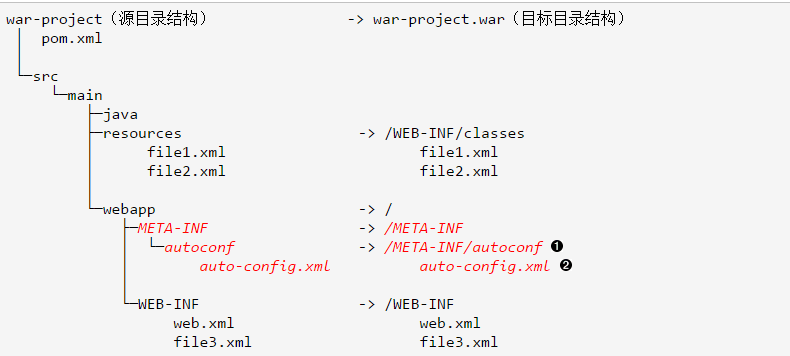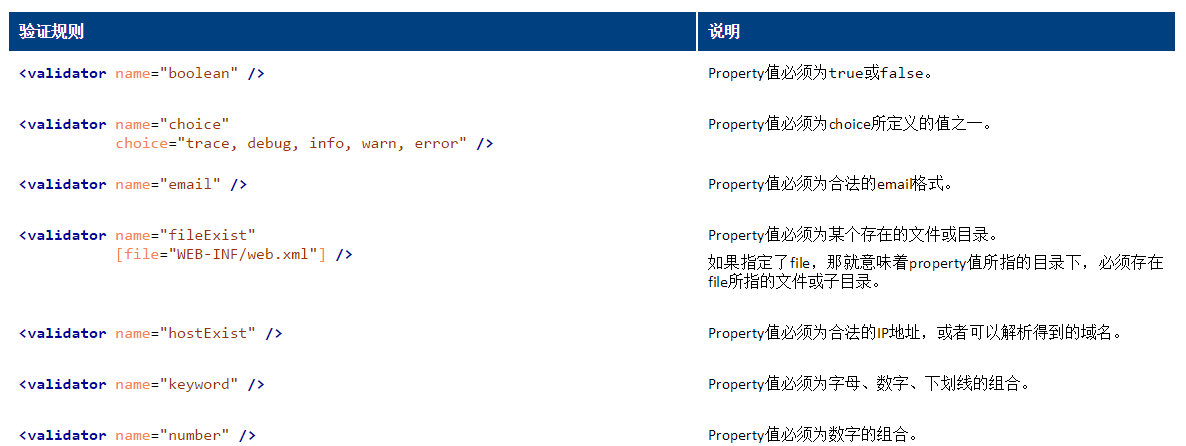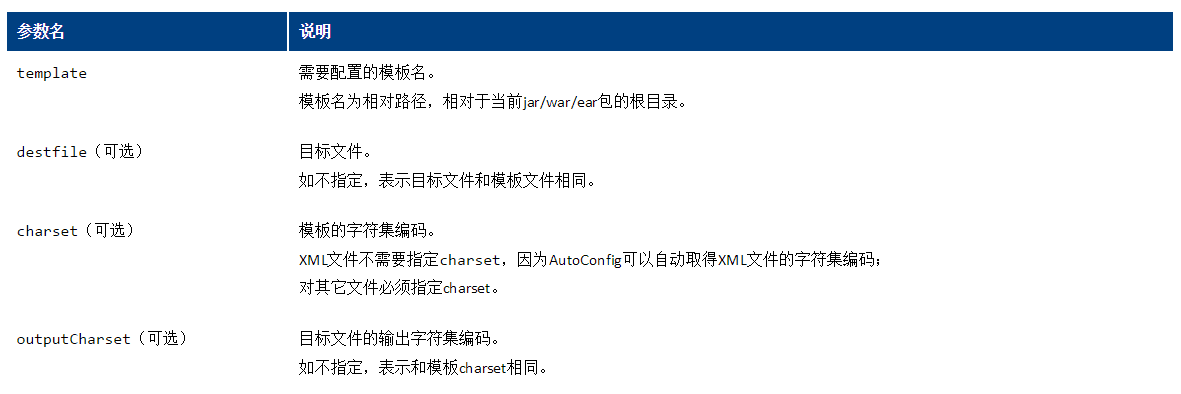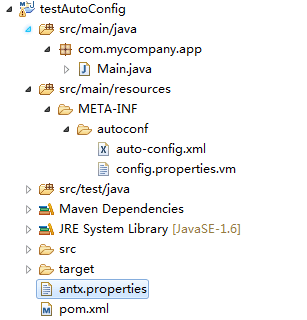1.安装
(1)从maven repository中下载autoconfig-1.2.tgz和autoexpand-1.2.tgz
-
http://repo1.maven.org/maven2/com/alibaba/citrus/tool/antx-autoconfig/1.2/antx-autoconfig-1.2.tgz
-
http://repo1.maven.org/maven2/com/alibaba/citrus/tool/antx-autoexpand/1.2/antx-autoexpand-1.2.tgz
实际上就是将解压出来的文件复制到system32文件夹下(windows)
(3)在命令行中执行autoconfig命令,如果出现下图则说明安装成功
2.目录写法
(1)war包的目录结构(maven项目)
(2)jar包的目录结构(maven项目)
3.auto-config.xml文件
(1)作用
实际上就是模板文件和实际参数文件之间的桥梁,模板文件中存储placeholder,实际参数文件中存储实际环境参数
(2)组成1)properties定义
指定properties的名称、描述、默认值、约束条件等信息
2)指定包含placeholders的模板文件
指定使用哪个模板,并且指定生成的文件的位置
(3)实例
<?xml version="1.0" encoding="UTF-8"?>
<config>
<group name="test">
<property name="petstore.work"
description="应用程序的工作目录" />
<property name="petstore.loggingRoot"
defaultValue="${petstore.work}/logs"
description="日志文件目录" />
<property name="petstore.upload"
defaultValue="${petstore.work}/upload"
description="上传文件的目录" />
<property name="petstore.loggingLevel"
defaultValue="warn"
description="日志文件级别">
<validator name="choice"
choice="trace, debug, info, warn, error" />
</property>
</group>
<script>
<generate template="config.properties.vm" destfile="biz/config.properties" charset="UTF-8"/>
<generate template="WEB-INF/common/resources.xml" />
</script>
</config>
(4)定义property
1)定义
<property
name="..."
[defaultValue="..."]
[description="..."]
[required="true|false"]
>
<validator name="..." />
<validator name="..." />
...
</property> 2)可用的参数
3)property的验证规则
(4)生成配置文件的指令
auto-config.xml中,每个<generate>标签指定了一个包含placeholders的配置文件模板
1)格式
<generate
template="..."
[destfile="..."]
[charset="..."]
[outputCharset="..."]
>
4.模板文件
(1)作用
实模板文件中存储placeholder,等待填充实际参数
(2)位置一般在auto-config.xml所在目录下(也可以在包的根目录中)
(3)写法
1)希望被替换的地方配置成placeholder:"${property.name}"
2)不希望被替换的地方改为“${D}{...}”
(4)实例
################## basic config ################
alibaba.intl.s2s.tddl.appname=${alibaba_intl_s2s_tddl_appname}
alibaba.intl.s2s.idservice.version=${alibaba_intl_s2s_idservice_version}
alibaba.intl.s2s.jingwei.taskname=${alibaba_intl_s2s_jingwei_taskname}5.实际参数存储文件
现在定义placeholder的auto-config.xml,含有placeholder的模板xx.properties.vm也有了,只差定义数据了
(1)位置
1)当前工作目录的antx.properties文件2)${user.home}/antx.properties文件
(2)写法
和properties文件完全相同,例如net.kiminotes.value = hello, world
6.在pom.xml中配置maven autoconfig插件
整个pom如下
<project xmlns="http://maven.apache.org/POM/4.0.0" xmlns:xsi="http://www.w3.org/2001/XMLSchema-instance"
xsi:schemaLocation="http://maven.apache.org/POM/4.0.0 http://maven.apache.org/maven-v4_0_0.xsd">
<modelVersion>4.0.0</modelVersion>
<groupId>com.mycompany.app</groupId>
<artifactId>testAutoConfig</artifactId>
<packaging>jar</packaging>
<version>1.0-SNAPSHOT</version>
<name>testAutoConfig</name>
<url>http://maven.apache.org</url>
<build>
<plugins>
<plugin>
<groupId>com.alibaba.citrus.tool</groupId>
<artifactId>maven-autoconfig-plugin</artifactId>
<version>1.0.9</version>
<executions>
<!-- 配置在package phase中运行maven-autoconfig-plugin的autoconfig goal -->
<execution>
<id>config</id>
<goals>
<goal>autoconfig</goal>
</goals>
<phase>package</phase>
</execution>
</executions>
</plugin>
<plugin>
<artifactId>maven-jar-plugin</artifactId>
<configuration>
<archive>
<!-- 打出的jar包中的 MANIFEST.MF 文件中增加 Main-Class 这一项配置,这样就能在命令行中通过 java -jar 来执行打出的jar包 -->
<manifestEntries>
<Main-Class>com.mycompany.app.Main</Main-Class>
</manifestEntries>
</archive>
</configuration>
</plugin>
<plugin>
<groupId>org.apache.maven.plugins</groupId>
<artifactId>maven-compiler-plugin</artifactId>
<version>2.3.2</version>
<configuration>
<target>1.6</target>
<source>1.6</source>
</configuration>
</plugin>
</plugins>
</build>
<dependencies>
<dependency>
<groupId>junit</groupId>
<artifactId>junit</artifactId>
<version>3.8.1</version>
<scope>test</scope>
</dependency>
</dependencies>
</project>
7.使用实例
(1)创建auto-config.xml文件
<?xml version="1.0" encoding="UTF-8"?>
<config>
<group>
<property name="net.kiminotes.value" />
</group>
<script>
<generate template="config.properties.vm" destfile="config.properties" charset="utf-8" />
</script>
</config> key = ${net_kiminotes_value} 如前配置
(4)编写测试类
com.mycompany.app.Main
package com.mycompany.app;
import java.io.IOException;
import java.io.InputStream;
import java.util.Properties;
public class Main
{
public static void main( String[] args ) throws IOException
{
InputStream is = Main.class.getClassLoader().getResourceAsStream( "config.properties" );
if ( is == null )
{
System.err.println( "Can not load config resource config.properties in classpath" );
}
else
{
Properties prop = new Properties();
prop.load( is );
is.close();
for( String key : prop.stringPropertyNames() )
{
String value = prop.getProperty( key );
if ( value != null )
{
System.out.printf( "%s = %s %n", key, value );
}
}
}
}
}
(5)项目打包
mvn clean package -DskipTests
(6)执行编写的jar
java -jar target/testAutoConfig-1.0-SNAPSHOT.jar
结果为:key = hello,world
(7)附项目目录































 807
807

 被折叠的 条评论
为什么被折叠?
被折叠的 条评论
为什么被折叠?








